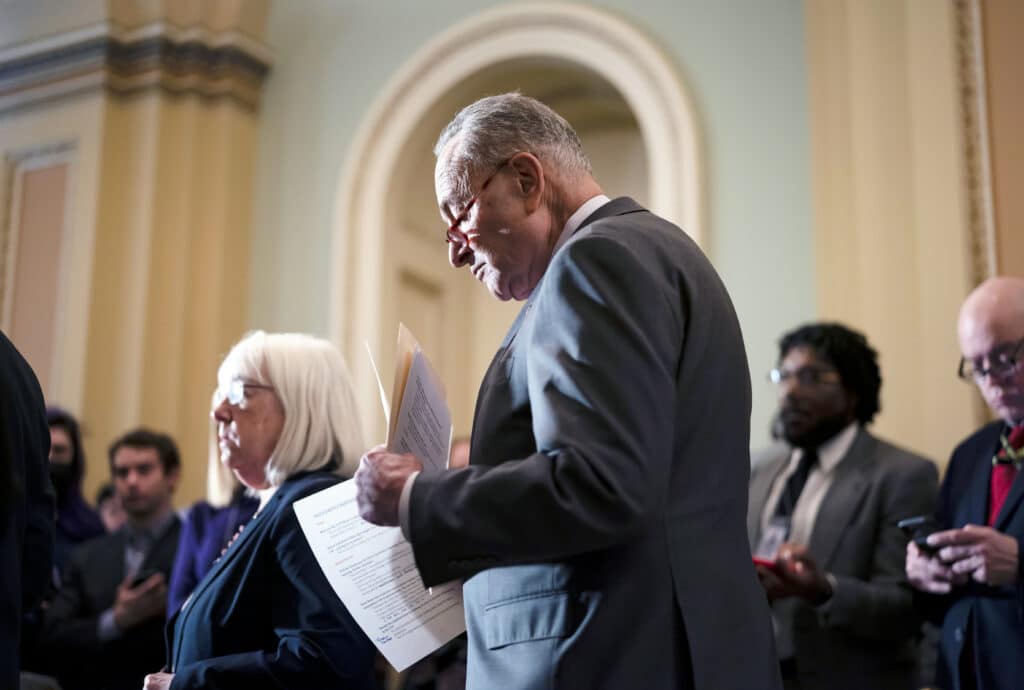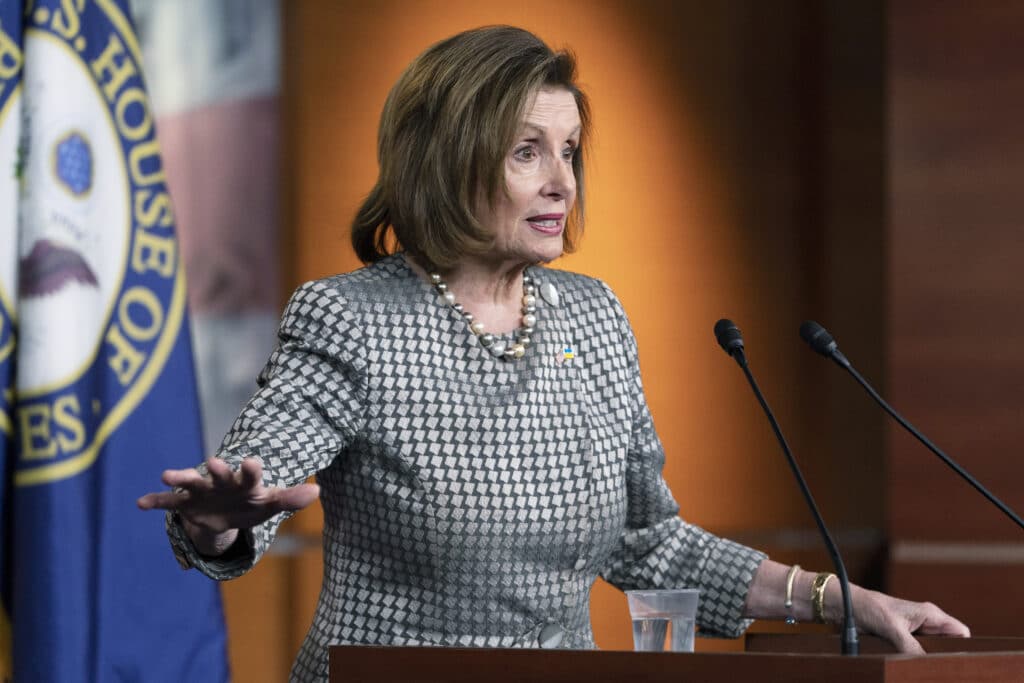Democrats in Congress have decided to drop pursuing more COVID-19 funds, since it would require cutting previously approved pandemic assistance to the states. Instead, House Speaker Nancy Pelosi said she will focus on $1.5 trillion legislation for Ukraine and European allies. The Associated Press has the story:
Congress up against another spending deadline to keep government from shutting down
WASHINGTON (AP) — Democratic leaders abruptly abandoned plans for a fresh infusion of $15.6 billion for battling the COVID pandemic on Wednesday, clearing the way for House debate and passage of a vast government spending bill that is anchored by aid for Ukraine and European allies.
House Speaker Nancy Pelosi, D-Calif., announced that the COVID-19 spending would be removed from the package after rank-and-file lawmakers objected that it would be paid for, in part, by cutting previously approved pandemic assistance to their states.
“We must proceed” with the government-wide $1.5 trillion legislation because of the urgency of helping Ukraine and the bill’s spending for other programs, Pelosi wrote in a letter to colleagues.

“It is heartbreaking to remove the COVID funding, and we must continue to fight for urgently needed COVID assistance, but unfortunately that will not be included in this bill,” she said.
While Democrats had insisted on including the pandemic money in the sprawling, bipartisan legislation, Republicans demanded it be paid for with cuts elsewhere. After hours of talks, Pelosi relented to Democratic lawmakers who were refusing to let the measure move forward unless the earlier funds their states were supposed to receive were protected.
It was unclear whether Congress will be able to revive the dropped COVID-19 funds — which were largely aimed at providing more vaccines, treatments and tests — in future legislation. For now, the confrontation stood as a remarkable rank-and-file rebellion that succeeded in eliminating pandemic spending that leading Democrats, including Senate Majority Leader Chuck Schumer, D-N.Y., had said was a top priority.
The money countering the Russian blitzkrieg t hat’s devastated parts of Ukraine and triggered that continent’s biggest refugee exodus since World War II ensured that the overall bill would ultimately pass with robust support from both parties. President Joe Biden requested $10 billion for the military, humanitarian and economic aid last week, and backing in Congress was so staunch that the figure grew to $13.6 billion in just days.

“The people of Ukraine are courageously standing up for freedom,” Rep. Jim McGovern, D-Mass., said as debate began. “Congress, the Biden administration and the people of the United States must stand with them.”
Party leaders planned to whip the 2,741-page measure through the House on Wednesday and the Senate by week’s end, though that chamber’s exact timing was unclear.
Lawmakers were spurred to act quickly by the urgency of helping Ukraine before Russia’s military might makes it too late. They also faced a Friday deadline to approve the government-wide spending measure or face a weekend election-year federal shutdown. As a backstop against delays, the House planned to pass a bill Wednesday keeping agencies afloat through March 15.
“At the end of the day, it represents a good balance for Congress and the nation,” Rep. Tom Cole, R-Okla., said of the legislation.
Over $4 billion of the Ukraine aid was to help the country and Eastern European nations cope with the 2 million refugees who’ve already fled the fighting. Another $6.7 billion was for the deployment of U.S. troops and equipment to the region and to transfer American military items to Ukraine and U.S. allies, and there was economic aid and money to enforce economic sanctions against Russia as well.

The bipartisan rallying behind the Ukraine aid was just one manifestation of Congress’ eagerness to help the beleaguered country, though not all of it has been harmonious.
Republicans accused Biden of moving too slowly to help Ukraine and NATO allies and to impose sanctions against Russia and its president, Vladimir Putin. Democrats countered that time was needed to bring along European allies that rely heavily on Russian energy sources. And a bipartisan push to ban Russian oil imports had become nearly unstoppable before Biden announced Tuesday that he would do that on his own.
The huge overall bill was stocked with victories for both parties.
For Democrats, it provides $730 billion for domestic programs, 6.7% more than last year, the biggest boost in four years. Republicans won $782 billion for defense, 5.6% over last year’s levels.
In contrast, Biden’s 2022 budget last spring proposed a 16% increase for domestic programs and less than 2% more for defense — numbers that were doomed from the start thanks to Democrats’ slender congressional majorities.
The bill was also fueled by large numbers of hometown projects for both parties’ lawmakers, which Congress had banned since 2011 but were revived this year. The spending — once called earmarks, now dubbed community projects — includes money for courthouses in Connecticut and Tennessee and repairs to a post office in West Virginia. And it names a federal building in Tuscaloosa, Alabama, after Sen. Richard Shelby, the state’s senior GOP senator, a chief author of the bill who’s retiring after six terms.
Democrats won a fresh round of spending for vaccines, testing and treatments for COVID-19, including $5 billion for fighting the pandemic around the world. That was below Biden’s $22.5 billion request.
Republicans said they’d forced Democrats to pay for the entire amount by pulling back money from COVID-19 relief bills enacted previously. Much of the money was to go to help states and businesses cope with the toll of the pandemic.
There’s added money for child care, job training, economic development in poorer communities and more generous Pell grants for low-income undergraduates. Public health and biomedical research would get increases, including $194 million for Biden’s “Cancer Moonshot” effort to cure the disease.
Citizenship and Immigration Services would get funds to reduce huge backlogs of people trying to enter the U.S. There would be fresh efforts to bolster renewable energy and curb pollution, with some of that aimed specifically at communities of color.
The measure renews programs protecting women against domestic violence and requires many infrastructure operators to report significant cyber attacks and ransomware demands to federal authorities. The Defense Department would have to report on extremist ideologies within the ranks.
The measure retains strict decades-old curbs against using federal money for nearly all abortions. It has $300 million in military assistance for Ukraine and $300 million to help nearby countries like the Baltic nations and Poland. Service members would get 2.7% pay raises, and Navy shipbuilding would get a boost in a counter to China.
Since the government’s fiscal year began last Oct. 1, agencies have been running on spending levels approved during Donald Trump’s final weeks in the White House.
___
By ALAN FRAM
Associated Press writer Farnoush Amiri contributed to this report.







